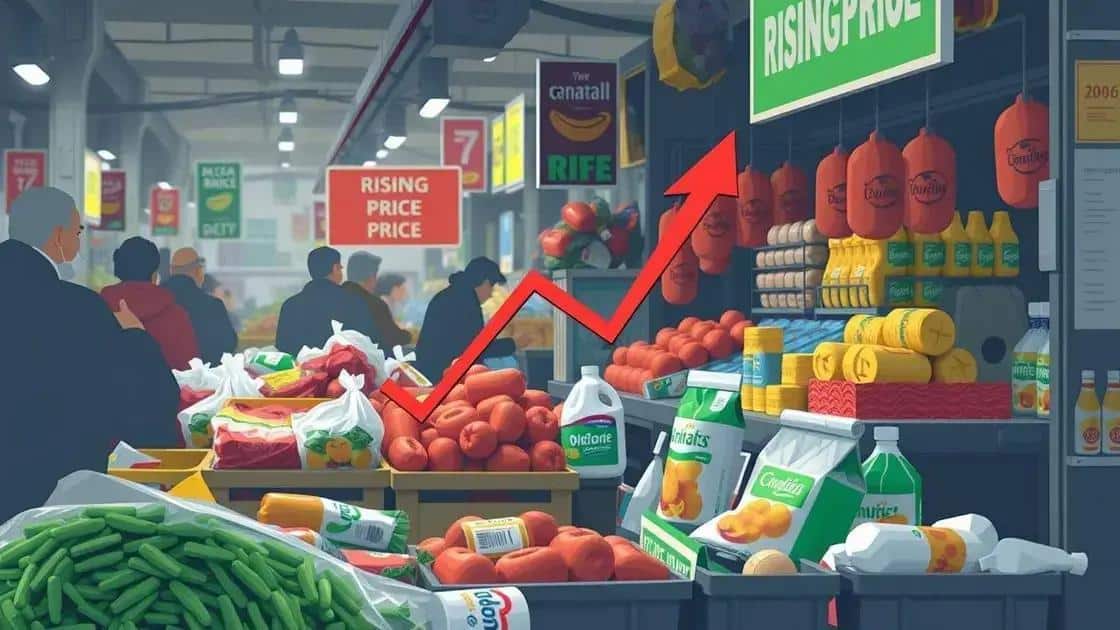Tariff-induced inflation: what it means for your wallet

Tariff-induced inflation occurs when government tariffs increase the cost of imports, causing prices to rise for consumers and affecting overall market dynamics.
Tariff-induced inflation is a term on everyone’s lips these days, raising questions about how trade policies affect our pocketbooks. Curious about how tariffs could reshape your spending habits? Let’s dive into this topic.
Understanding tariff-induced inflation
Understanding tariff-induced inflation is essential for anyone wishing to grasp how economic decisions shape prices across the market. When tariffs are imposed on imported goods, they can significantly influence the overall cost of products that consumers buy every day.
Tariffs can lead to an increase in prices for consumers because importers typically pass on their increased costs. This phenomenon is often described as price inflation due to tariffs. But how does this occur? Let’s break it down.
How Tariffs Affect Prices
When a government imposes a tariff, it essentially sets a tax on imported goods. This can lead to higher costs for businesses that rely on foreign products. Most often, businesses will then raise prices to maintain their profit margins. Some key points to consider include:
- Increased costs for manufacturers
- Higher retail prices for consumers
- Potential price hikes across various sectors
These changes can be subtle or dramatic, depending on the scale of the tariffs. As consumers face higher prices, their purchasing power decreases, affecting overall spending.
Impacts on the Economy
Tariff-induced inflation doesn’t just impact individual prices; it can also shift economic trends and consumer behavior. For example, when prices rise, consumers may decide to:
- Reduce spending on non-essential items
- Switch to cheaper alternatives or local products
- Reallocate their budgets to accommodate rising costs
This shift in consumer behavior can have wide-reaching implications for businesses and the economy as a whole. Understanding these dynamics helps consumers make informed decisions regarding their spending.
In summary, grasping how tariffs can induce inflation enables consumers to anticipate price changes and adapt their financial strategies accordingly. Being aware of these changes is crucial in today’s global economy, especially as trade policies continue to evolve.
Causes of tariff-induced inflation

Causes of tariff-induced inflation arise from several interconnected factors that influence the marketplace and consumer behavior. When governments implement tariffs, the intent is often to protect local industries, but this policy can lead to higher prices for consumers.
The primary cause of tariff-induced inflation is the increased cost burden placed on importers. When tariffs are set, importers face higher expenses and typically transfer some of these costs to consumers. This price increase can significantly affect everyday goods.
Key Factors Leading to Tariff-Induced Inflation
Several underlying factors contribute to this phenomenon:
- Increased Import Costs: Tariffs raise the prices of imported goods, leading to higher costs for businesses.
- Profit Margin Adjustments: Companies may decide to increase their prices to maintain profit margins in response to new costs.
- Reduced Supply of Goods: Tariffs can limit the availability of certain products, driving up demand and, consequently, prices.
When import prices rise, businesses that rely on these goods to produce their products may also increase prices. This chain reaction can lead to widespread inflation in various sectors.
Economic Responses to Tariffs
The economic responses to tariffs are another significant cause of inflation. For instance, as businesses face rising costs, they might:
- Cut Back on Production: This can create shortages in the market.
- Seek Alternative Suppliers: Often leading to fluctuating prices as markets adjust.
- Pass Costs to Consumers: Resulting in an overall increase in consumer prices.
These shifts can alter consumer behavior, impacting purchasing decisions widely. As goods become more expensive, consumers might start prioritizing essential items over luxury ones. This shift can change the shopping landscape.
Understanding these causes helps consumers comprehend why prices fluctuate. Awareness of how tariffs influence the economy makes it easier to navigate spending and budget decisions in a fluctuating market.
Effects on consumer prices
The effects on consumer prices due to tariff-induced inflation are significant and can be felt across various sectors. When tariffs are implemented, they often lead to a rise in the prices that consumers pay for goods and services.
This increase in prices stems primarily from businesses needing to cover higher import costs. As tariffs raise expenses on imported products, companies frequently pass these costs onto consumers. This can create higher retail prices, narrowing the options available for shoppers on a budget.
How Tariffs Impact Prices Directly
Several direct effects can influence consumer pricing:
- Increased Costs of Goods: Tariffs create a direct increase in the cost of imported items.
- Price Adjustments by Retailers: Stores often raise prices to maintain profit margins when faced with higher costs.
- Impact on Local Production: Domestic producers may also raise their prices in response to increased competition for local goods.
As prices rise, consumers may begin to notice the impact on their everyday shopping. Items that were once affordable may no longer fit their budgets, leading them to seek out alternative products.
Long-Term Price Effects on the Economy
In addition to immediate price increases, there could be long-term effects on consumer behavior. With continuously rising prices, consumers might:
- Shift to Generic Brands: Seeking more affordable options as prices rise.
- Reduce Overall Spending: Cutting back on non-essential goods.
- Change Shopping Habits: Focusing on sales and lower-priced items.
These behavior changes can alter market dynamics significantly. As consumers seek more budget-friendly options, businesses may need to adjust their strategies to meet new demands.
Overall, understanding the effects on consumer prices due to tariffs enables consumers to navigate their purchasing decisions more effectively. Awareness of these changes can empower shoppers to make informed choices in a fluctuating market.
Strategies to manage rising costs

Effective strategies to manage rising costs become essential when faced with tariff-induced inflation. As prices for goods and services climb, consumers and businesses alike must adapt to maintain their financial well-being.
One common approach is budgeting carefully. By tracking expenses and understanding where the majority of costs come from, individuals can make more informed decisions. Cutting back on unnecessary spending is another effective way to cope with rising prices.
Practical Cost-Management Techniques
This involves various techniques that help control spending:
- Prioritize Essential Expenses: Focus your budget on what truly matters, such as food and healthcare.
- Seek Out Discounts: Look for sales, coupons, or bulk purchase options to reduce costs on everyday items.
- Explore Generic Brands: Often, store brands provide similar quality at a lower price.
Shopping smartly and making conscious decisions can go a long way in dealing with increased costs.
Adapting to Market Changes
It is also important to stay informed about market trends related to inflation and tariffs. Understanding when to make a purchase can help consumers save money. Similarly, businesses can adjust pricing strategies or find alternative suppliers to mitigate the impact of rising costs.
Hiring experts to analyze financial situations and provide guidance can also be a wise investment. This kind of insight could help both consumers and businesses navigate challenging economic climates effectively.
In managing rising costs, flexibility and knowledge are key. By adopting these strategies, individuals can better cope with the changes in the landscape of consumer prices while maintaining financial stability.
Understanding the complexities of tariff-induced inflation helps consumers and businesses alike navigate a changing economic environment. By recognizing the causes and effects, it becomes easier to adapt to rising prices and manage expenses. Employing effective strategies to cope with these changes is essential for maintaining financial stability. Staying informed and making smart choices can significantly impact how individuals handle their budgets in the face of inflation. Ultimately, awareness and adaptability are key to thriving in an economy shaped by tariffs and rising costs.
FAQ – Frequently Asked Questions about Tariff-Induced Inflation
What is tariff-induced inflation?
Tariff-induced inflation occurs when government-imposed tariffs raise import costs, leading to increased prices for consumers.
How can consumers manage rising costs due to tariffs?
Consumers can manage rising costs by budgeting carefully, seeking discounts, and considering generic brands for savings.
What are the long-term effects of tariffs on consumer prices?
Long-term effects may include sustained higher prices and shifts in consumer behavior towards buying less or opting for cheaper alternatives.
How do tariffs impact local businesses?
Tariffs can lead to increased production costs for local businesses, prompting them to raise prices or seek cost-cutting measures.






